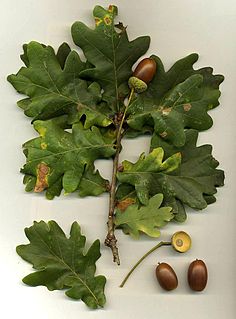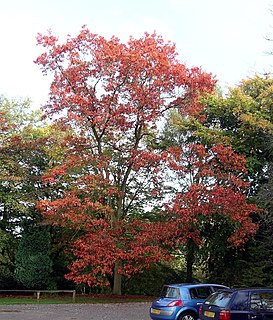
An oak is a tree or shrub in the genus Quercus of the beech family, Fagaceae. There are approximately 500 extant species of oaks. The common name "oak" also appears in the names of species in related genera, notably Lithocarpus, as well as in those of unrelated species such as Grevillea robusta and the Casuarinaceae (she-oaks). The genus Quercus is native to the Northern Hemisphere, and includes deciduous and evergreen species extending from cool temperate to tropical latitudes in the Americas, Asia, Europe, and North Africa. North America contains the largest number of oak species, with approximately 90 occurring in the United States, while Mexico has 160 species of which 109 are endemic. The second greatest center of oak diversity is China, which contains approximately 100 species.

Quercus rubra, the northern red oak, is an oak tree in the red oak group. It is a native of North America, in the eastern and central United States and southeast and south-central Canada. It grows from the north end of the Great Lakes, east to Nova Scotia, south as far as Georgia, Mississippi, Alabama, and Louisiana, and west to Oklahoma, Kansas, Nebraska, and Minnesota. It has been introduced to small areas in Western Europe, where it can frequently be seen cultivated in gardens and parks. It prefers good soil that is slightly acidic. Often simply called red oak, northern red oak is so named to distinguish it from southern red oak, also known as the Spanish oak. It is sometimes called champion oak. It is also the state tree of New Jersey and the provincial tree of Prince Edward Island.

Fagaceae is a family of flowering plants that includes beeches and oaks, and comprises eight genera with about 927 species. The Fagaceae are mostly deciduous but often evergreen trees and shrubs, characterized by alternate simple leaves with pinnate venation, unisexual flowers in the form of catkins, and fruit in the form of cup-like (cupule) nuts. Their leaves are often lobed and both petioles and stipules are generally present. Their fruits lack endosperm and lie in a scaly or spiny husk that may or may not enclose the entire nut, which may consist of one to seven seeds. In the oaks, genus Quercus, the fruit is a non-valved nut called an acorn. The husk of the acorn in most oaks only forms a cup in which the nut sits. Other members of the family have fully enclosed nuts. Fagaceae is one of the most ecologically important woody plant families in the Northern Hemisphere, as oaks form the backbone of temperate forest in North America, Europe, and Asia and one of the most significant sources of wildlife fodder.

A lignotuber is a woody swelling of the root crown possessed by some plants as a protection against destruction of the plant stem, such as by fire. The crown contains buds from which new stems may sprout, as well as stores of starch that can support a period of growth in the absence of photosynthesis. The term "lignotuber" was coined in 1924 by Australian botanist Leslie R. Kerr.

Quercus robur, commonly known as common oak, pedunculate oak, European oak or English oak, is a species of flowering plant in the beech and oak family, Fagaceae. It is native to most of Europe west of the Caucasus. The tree is widely cultivated in temperate regions and has escaped into the wild in scattered parts of China and North America.

Quercus suber, commonly called the cork oak, is a medium-sized, evergreen oak tree in the section Quercus sect. Cerris. It is the primary source of cork for wine bottle stoppers and other uses, such as cork flooring and as the cores of cricket balls. It is native to southwest Europe and northwest Africa. In the Mediterranean basin the tree is an ancient species with fossil remnants dating back to the Tertiary period.

Quercus petraea, commonly known as the sessile oak, Cornish oak, Irish Oak or durmast oak, is a species of oak tree native to most of Europe and into Anatolia and Iran. The sessile oak is the national tree of the Republic of Ireland, and an unofficial emblem in Wales and Cornwall.

Quercus virginiana, also known as the southern live oak, is an evergreen oak tree endemic to the Southeastern United States. Though many other species are loosely called live oak, the southern live oak is particularly iconic of the Old South. Many very large and old specimens of live oak can be found today in the Deep South region of the United States.

Live oak or evergreen oak is any of a number of oaks in several different sections of the genus Quercus that share the characteristic of evergreen foliage. These oaks are not more closely related to each other than they are to other oaks.

Quercus agrifolia, the California live oakcoast live oak, or holm oak, is a highly variable, often shrubby evergreen oak tree, a type of live oak, native to the California Floristic Province. It grows west of the Sierra Nevada mountain range from Mendocino County, California, south to northern Baja California in Mexico. It is classified in the red oak section of oaks.

The acorn, or oaknut, is the nut of the oaks and their close relatives. It usually contains one seed, enclosed in a tough, leathery shell, and borne in a cup-shaped cupule. Acorns are 1–6 centimetres long and 0.8–4 cm broad. Acorns take between 6 and 24 months to mature; see the list of Quercus species for details of oak classification, in which acorn morphology and phenology are important factors.

An oak savanna is a type of savanna-or lightly forested grassland- where oaks are the dominant trees, the term oakery or woodlands is also used commonly, though the former is more prevalent when referencing the Mediterranean area. These savannas were maintained historically through wildfires set by lightning, humans, grazing, low precipitation, and/or poor soil.

Gall wasps, also called gallflies, are a family (Cynipidae) in the wasp superfamily Cynipoidea within the suborder Apocrita of the order Hymenoptera. Their common name comes from the galls they induce on plants for larval development. About 1,300 species of this generally very small creature (1–8 mm) are known worldwide, with about 360 species of 36 different genera in Europe and some 800 species in North America.

Grevillea robusta, commonly known as the southern silky oak, silk oak or silky oak, silver oak or Australian silver oak, is a flowering plant in the family Proteaceae. It is a tree, the largest species in its genus but is not closely related to the true oaks, Quercus. It is a native of eastern coastal Australia, growing in riverine, subtropical and dry rainforest environments.

Grevillea hilliana, of the plant family Proteaceae, is a species of Australian endemic trees known by many common names including white yiel yiel, white silky oak, grey oak, Hill's silky oak, and yill gill.

Eidothea hardeniana, commonly named nightcap oak, is a species of tree, up to 40 m (130 ft) tall, of the plant family Proteaceae, which botanist Robert Kooyman recognised as a new species only recently in 2002. The species has an official listing as critically endangered on the Australian Commonwealth EPBC Act and as Endangered on the NSW Threatened Species Act. The name hardeniana honours the botanist Gwen Harden. Phylogenetics studies now suggest it represents a basal branch of the Proteoid clade of the Proteaceae.

A dehesa is a multifunctional, agrosylvopastoral system and cultural landscape of southern and central Spain and southern Portugal; in Portugal, it is known as a montado. Its name comes from the Latin 'defensa' (fenced) referring to land that was fenced, and usually destined for pasture. Dehesas may be private or communal property. Used primarily for grazing, they produce a variety of products, including non-timber forest products such as wild game, mushrooms, honey, cork, and firewood. They are also used to raise the Spanish fighting bull and the Iberian pig. The main tree component is oaks, usually holm and cork. Other oaks, including melojo and quejigo, may be used to form dehesa, the species depending on geographical location and elevation. Dehesa is an anthropogenic system that provides not only a variety of foods, but also wildlife habitat for endangered species such as the Spanish imperial eagle.
Neorites is a genus of a sole described species of tall trees, constituting part of the plant family Proteaceae. The species Neorites kevedianus is endemic to the wet tropics rainforests of north eastern Queensland, Australia. The trees have the common names of the fishtail oak or fishtail silky oak.
Sphalmium is a monotypic genus of flowering plants in the protea family. The only species, Sphalmium racemosum, is a large forest tree. Common names include satin silky oak, mystery oak, Mt Lewis oak, poorman's fishtail oak and buff silky oak.















